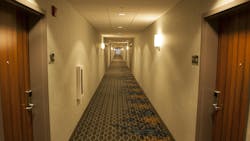Tactical Geometry: Training Officers to Navigate the Shape of Calls
In any building clearing, SWAT, active shooter response or other “tactical” class you take, there will be discussion of how to best navigate corners, doorways, etc. As you consider the best way to approach, move into and/or pass through each of these potentially dangerous transitions, you are using geometry even though you swore you’d never have a need for it when you took it in high school. Do you still study it?
This article appeared in the January/February issue of OFFICER Magazine. Click Here to subscribe to OFFICER Magazine.
“Tactical” is defined (by dictionary.com) as: “of or relating to a maneuver or plan of action designed as an expedient designed toward gaining a desired end or temporary advantage.”
(NOTE: for the purposes of this article we are not using “tactical” to describe officers, i.e SWAT or special team members, but instead as a way of thinking and behaving during the performance of your duties.)
“Geometry” is defined as: “the branch of mathematics describing points, lines, angles and figures in space, that operates in accordance with a specific set of assumptions.”
If you don’t consider “tactical geometry” applicable to building searches, using cover or concealment, or generally assessing your environment for potential threats, we believe you should reconsider your outlook. At its most basic, every structure is composed of lines and curves, and every one of them that you encounter is processed and evaluated. You either consider there to be no threat, a potential threat, or an immediate threat depending on what you find on the other side. Every doorway is a rectangle; every hallway intersection a combination of vertical and horizontal lines; every piece of furniture or appliance a combination of lines and curves. Think about that and decide whether or not “tactical geometry” is something worth studying. We submit that you already have and should continue to do so.
Through the decades, we in law enforcement have developed tactics and protocols for how we approach, clear and enter doorways and rooms. Turning corners in hallways is referred to as “slicing the pie,” and there we are using geometric terms to describe a tactical behavior. The tactic of slicing the pie allows you to minimize your exposure to potential risk while empowering you to have maximum discovery and control of a potential threat.
Slicing the pie is accomplished by approaching a vertical line at a gradually decreasing angle to the perpendicular cross-line, at the maximum possible distance from the pivot point (intersection of vertical line with cross-line while standing on the horizontal plane). It’s three-dimensional thinking and movement at its best and is all about the relationship of an object (the threat) to the lines being “worked.”
While we don’t think about it, this same tactic and all of the same terms apply to objects we have to search by looking over, under or around. There is a line at the top, or bottom, or side(s) that we have to approach and look around without exposing ourselves any more than necessary to function, always attempting to minimize our risk while maximizing our advantage over any potential threat we find.
The other environmental condition we have to keep in mind is that we operate in a 720 degree environment. Virtually every officer is taught to maintain an awareness of their surroundings, but we’re not usually taught to consider what’s above or below us unless we’re in building search situations or responding to multi-level motels/garden apartment structures. We operate in a 360 degree environment on the horizontal—what’s around us, front, sides and rear—but we also operate in a 360 degree environment on the vertical—what’s below us, in front of us, above us and behind us. The vertical and horizontal planes cross at whatever two points in space around us depending on setting and circumstance, but if you’ve been thinking you operate only in a 360 degree environment, we encourage you to reconsider.
We also measure our operational existence in three planes: height, width and depth, but there is a fourth dimension, that of time, that plays a significant role in everything we do. Yes, when we add in that fourth dimension we start to cross from geometry to calculus and/or physics, but our reality is strongly affected by the time constraints created by circumstance. For instance, if you’re searching a building, you can usually go as slow and deliberate as you want, maximizing time and tactics to your advantage. But if you’re responding to an active shooter event, you have to move as fast as you can and accept some risk as unavoidable to get to the threat as quickly as possible and neutralizing it, thereby minimizing the risk to innocents under your charge of protection.
When you are operating under time constraints as placed by circumstance or demand of duty, you are forced to perform your tactical geometry at a faster pace. Do you practice doing so? Most of the time, officers only practice tactical geometry either in practical (real life) application or when attending training for building searches or active shooter response. Interestingly, it’s something that can be practiced almost all the time, simply with some awareness and intent. How?
Every time you go into a business, even if it’s just a restaurant for lunch, pay attention to the doorways, sidewalks, approach landscaping, etc. Look at the shapes and lines. Identify what’s vertical, circular or curved, horizontal, above you, or down low. Consider your relationship to each and how it changes with every step you take. If you are entering a business or structure that has a lot of glass (not on an active service call), use that to your training advantage in the moment because you can see you approach angle, what your visibility angle is on the other side of the vertical line of the door or wall, and what shapes/lines might be presented as you breach the plane of entry. In doing so, you can feed your mind with visual experience that you can later call upon for practical application on calls.
This mental practice while no identified threat exists allows you to train your brain in a way you can later call upon, even subconsciously, as you make operational plans and decisions under stress. Anything that helps improve your performance under stress, given the profession of law enforcement, is a good thing.
About the Author
Lt. Frank Borelli (ret), Editorial Director
Editorial Director
Lt. Frank Borelli is the Editorial Director for the Officer Media Group. Frank brings 20+ years of writing and editing experience in addition to 40 years of law enforcement operations, administration and training experience to the team.
Frank has had numerous books published which are available on Amazon.com, BarnesAndNoble.com, and other major retail outlets.
If you have any comments or questions, you can contact him via email at [email protected].

